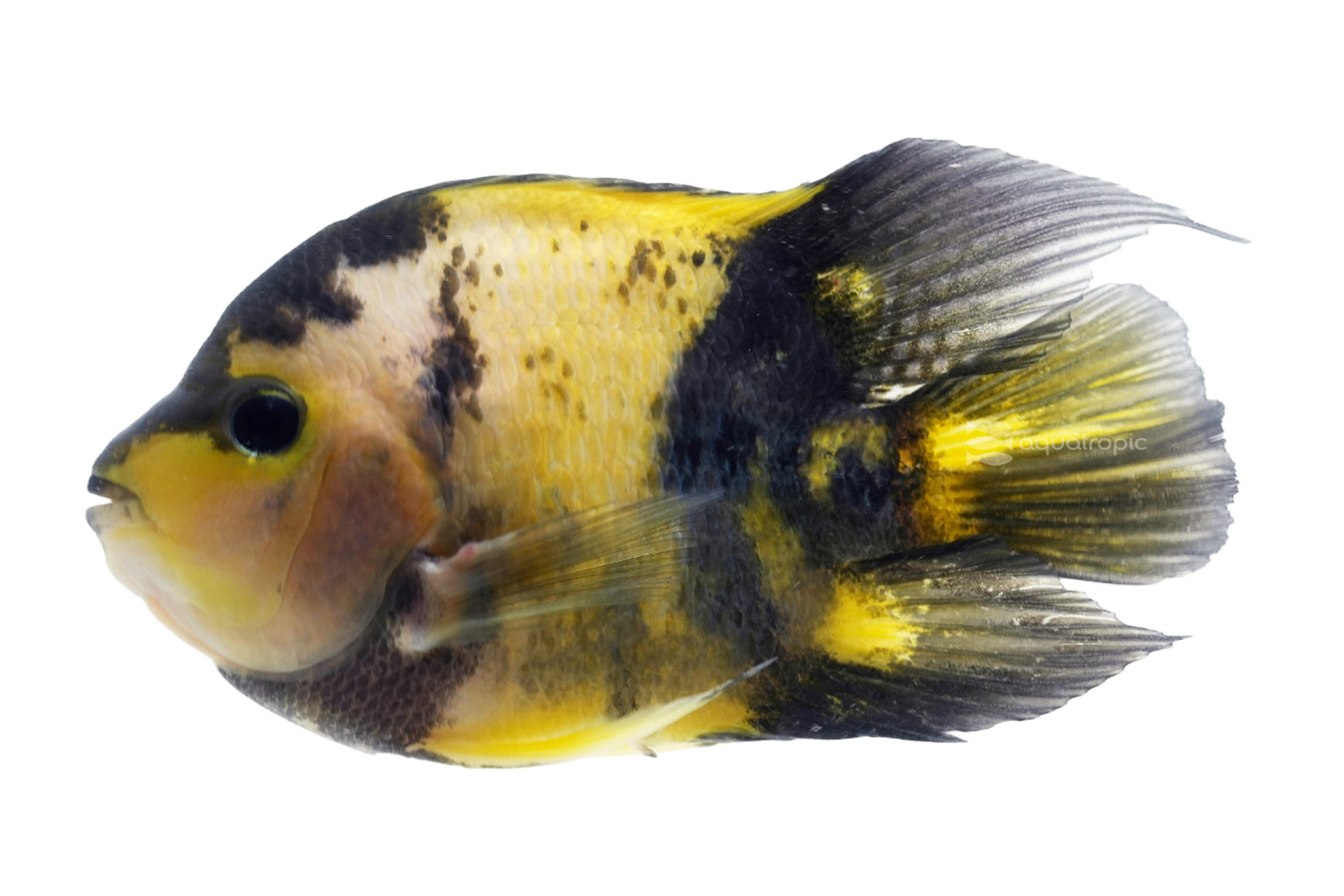Personable Parrot Pals

The Shortbody Yellow Tiger Parrot Cichlid is a human invention, the result of hybridizing a couple different (and very aggressive) cichlid species, and then many generations of selective breeding have resulted in a wide variety of aquarium fish that are strangely, very peaceful. This group of fish is widely called “Parrot” Cichlids but should not be confused with the True Parrot Cichlid (Hoplarchus psittacus), which is an article for another day.
While these false Parrot Cichlids come in a huge variety of colors and patterns, the Shortbody Yellow Tigers are aptly described, their torso being shorter than usual with golden yellow bodies and black splotches or stripes. Their fins are longer than they would be in any of the parent species, but not as long as some popular designer goldfish like Fantails. When the Parrot Cichlids are small, they are much less colorful, but they grow quickly and color up when they get a few inches long. They will continue this fast rate of growth up until they get mature at four or five inches long. The rate of growth rate slows down at that size, though they do keep growing and the males, which get a little bigger, will max out at seven or eight inches long.
These Parrots are not the most adept swimmers and don't need as much space as many other fish of similar size. We suggest a 55-to-75-gallon aquarium for a pair of them (plus some friends), but more can be kept together if you get a larger aquarium. Short Body Yellow Tiger Parrot Cichlids are notorious home flippers and will redecorate their environment constantly. As such, any plants will be regularly dug up, but never replanted. As diggers, they will appreciate a sandy substrate that is soft to prevent them from damaging themselves, though not so small as to remain suspended in the water column. Give them some large rocks or driftwood to help form some caves and sight line breaks but ensure that all of these are very securely placed directly on the bottom of the tank. They don't need or like bright light, and so either low intensity lighting can be used, or floating plants could also be used to help shade the display.
Shortbody Yellow Tiger Parrot Cichlid are not picky about water parameters and should be okay in most water profiles you are likely to encounter in North America. As with all aquarium water, tap water should be treated to remove chlorine and chloramine. As long as your water is in the upper 70's to low 80s Fahrenheit and has a pH close to 7.0, they should be fine as the Parrot Cichlid is not only very adaptable, but has been aquacultured for its entire existence, going back at least to the 1990s. They like big meals, and produce a lot of waste, but also do best in very clean water, so filtration should be aggressive and water changes should be frequent and large.
You could probably feed your Shortbody Parrot Cichlid just about anything. Seriously, these fish eat it all. The base of their diet should be a high-quality pellet like the Nutramar Algae and Color Boost, which we feed them here in house. Your fish will show the best color if you also feed them a variety of food, and some of this should be shrimp chunks with the shell on, or krill to get your fish enough carotene to enhance the orange / yellow / gold tones they show as adults. They will also happily take mysis, chopped seafood, brine, bloodworms, and live foods like earthworms (another food we suggest) and Brine for treats.
As we previously referenced, these fish are very peaceful and make a perfect showpiece fish for a community tank. They can happily be kept long term with medium to large Tetras and Barbs, Rasboras, Mollies, Swords, Danios Guaramis, Angelfish, Catfish, Plecos, etc. We would really only caution you about tankmates that are too small and might get eaten if the Parrots can catch them, or too aggressive and thus a risk for your Parrot to be bullied. Your Shortbody Yellow Tiger Parrot Cichlid is unlikely to bother invertebrates like clams or lobsters but will definitely try to eat decorative shrimp.
If you're interested in breeding Parrot Cichlids for yourself, it can be a bit of a crapshoot. Perhaps because of their long hybridizing history, many of the Parrot Cichlids will be infertile, which no one will know until they reach sexual maturity. They will still build nests and defend eggs, but they will usually consume these within a day or two when it becomes clear they are not fertile. You will need to have a large number of these fish to find fertile pairs. When mature, males are generally a little more robust and longer than the females of the same age.
You'll find Shortbody Yellow Tiger Parrot Cichlids to have amazing personality and intelligence. They learn to recognize people and are very interactive. You won't need a ton of other fish to make this tank amazing, but you could have as many of them as you can fit in your aquarium without overcrowding, and the list of other fish you can keep them with is long! These fish have many of the same engaging traits that their parent species have and you'll love having them in your tank. If this sounds like the kind of fish you're interested in having, then head to your LFS and ask them about Shortbody Yellow Tiger Parrot Cichlid from Aquatropic today!